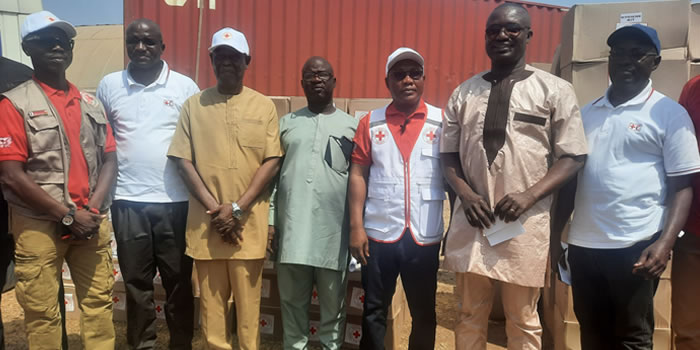

Modernised Agriculture
The main occupation of the people is agriculture involving crop production, fishing and livestock farming. About 65% of the population is estimated to be either directly or indirectly involved in agriculture. Teaching, civil service, petty trading and others constitute the remaining 35% of the population. Crop farmers are effectively occupied on their farms during the rainy season
Primary Production
The Central Gonja District is predominantly agricultural with about 80% of the District economically active population (18-54years) involved in various farming activities. Major food crops cultivated include yam, maize, cassava, sorghum, groundnuts, rice, millet, cowpea, bambara beans and soyabeans. It must be stressed that several farmers do mix cropping. Due to the availability of relatively fertile agricultural lands, crop output is quite high as compared to the national average as shown in the table in pdf file
Pest and Diseases Situation
The district identified high infestations of pest on cowpea fields as a major problem to farmers during the period to increase production. DADU carried out intensive farmer education through out the District on the use of pesticides to control pest and insects on cowpea fields.
The impact of 2004 demonstrations was realized as farmers adopted the following practices:
- The use of improved seed for planting
- Recommended spacing in planting
- Timely application of fertilizers
- Change from bad cultural practices.
As a result, DADU facilitated the sale of 250kg seed maize to 50 farmers and 134kg of cowpea to 27 farmers.
Livestock Performance
Livestock in the early parts of January to February (2005) experienced harsh conditions as a result of bush fires and draught. Livestock were lean due to inadequate pasture for grazing and water for drinking. The situation improved as a result of the improved soil moisture, which enhanced regeneration of the natural pasture in March. Livestock performance improved greatly both in growth and weight in the latter part of the period. This was due to abundance of natural pasture and water.
Animal Production
To increase livestock production DADU carried out educational programmes and Demonstration on livestock management in some selected communities. Farmers in Jiramoape have started adopting the technology.
Animal Health Activities
DADU carried out the following activities during the period under review to boost the livestock industry in the district. The activities include; deworming, castration, dipping/spraying, inspection of livestock for movement and slaughter. Below are the details of activities carried out in a tabular form.
Special Projects
The following projects are operative in the Central Gonja District:
- Food Crops Development Project (FCDP)
- Cashew Development Projects (CDP)
- Livestock Development Project (LPD)
- FARMER’ Project
- Farmer Based Organizations (FBOs)
- Agric Sub-Sector Improvement Programme (AgSSIP)
- Food and Agricultural Budgetary Support (FABS)
Tractor Services
Tractor services have been a problem to the district since the district has few tractors, to meet farmers demand for services. Due to this farmers had to depend on tractors from Tamale,Damongo and Kintampo for effective services
Availability of other farm Implements
The district lacks input dealers. However, DADU facilitated the acquisition of animal drawn implements (bullock and donkey ploughs, carts, and spare parts) to farmers on hire purchase from the Tamale Implement Factory.
Irrigation Development
The district has a great potential to develop irrigation, which will create employment for the youth. Currently, there are three (3) irrigation projects are at Buipe, Yapei and Wambong. Construction work on these projects is at an advance stage. The District Assembly in collaboration with DADU is in the process of developing some water bodies for irrigation farming in other communities. Constraints with Implementation of Planned Activities
The following are the setbacks, which were encountered during the implementation of DADU’s planned activities for the district.
- Inadequate means of transport
- Low mileage allowance (AEAs)
- Inadequate staff accommodation
- Inadequate field equipment
- Untimely and inadequate release of funds
Employment Generation, Improvement and Expansion of Safety Nets
Basically, the available area of employment is the agriculture sector. Even though some have engaged themselves in buying and selling this is rather on a small scale. The establishment of the Youth and Employment Policy by the Ministry of Manpower Youth and Employment would go a long way to solve some of the unemployment issues in the district. The modules are in Agric, Education and Health. The Youth and Employment Task Force in the District has started grouping the Youth into groups for assistance. These groups are going to be assisted with the following:
- Ploughing of their farms
- Supplying of farm inputs
- Supplying of fertilizer and seeds
- Building their capacity on farming
Date Created : 11/17/2017 5:02:36 AM











 facebook
facebook
 twitter
twitter
 Youtube
Youtube
 +233 593 831 280
+233 593 831 280 0800 430 430
0800 430 430 GPS: GE-231-4383
GPS: GE-231-4383 info@ghanadistricts.com
info@ghanadistricts.com Box GP1044, Accra, Ghana
Box GP1044, Accra, Ghana